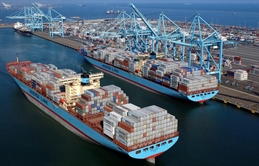
Maersk is pushing on with its integrator strategy that it unveiled early in 2018, but not everybody is convinced that this is the right course to chart.
In May the shipping giant announced a restructuring move that consolidates more logistics activities within the core outfit. Effective August 1 control of the landside activities of Maersk subsidiary APM Terminals shifts over to the company’s Maersk Logistics & Services arm.
The Inland Services part of APM Terminals comprises of 36 business units operating in over 100 locations around the globe, largely in Latin America and Africa. Its activities range from warehousing and local distribution services to container maintenance and repair. From August these will be marketed under the Maersk brand. The move leaves APM Terminals to focus on marine terminal operations and services rendered to Maersk as well as other carriers.
“By bringing together all operations skills and capabilities within logistics, it creates a base for growth and enables Maersk to excel in the execution within Logistics & Services products,” the company declared in a statement on the restructure.
“APM Terminals can fully focus on becoming a world class port operator, while Maersk, with the integration of Inland Services, will continue to focus on ocean transportation as well as logistics and services product development and delivery,” said Soren Toft, executive vice president and COO of A.P. Moller-Maersk (APMM).
The latest twist in Maersk’s set-up is a logical step on its road to morphing into an outfit that can offer end-to-end container services. Management unveiled this strategy early last year, arguing that the way forward would be to avoid commoditization of container shipping. Instead it wants to create value for customers by offering a broader range of logistics services.
APMM CEO Soren Skou has described the vision for his company’s future as “a global integrator of container logistics” that would allow shippers to arrange global moves with a single provider – Maersk. This would stretch to inland transport, customs brokerage, consolidation and other services.
The integrator terminology puts Maersk in line with the likes of FedEx and UPS, which have integrated transportation and retail sales and the supporting IT infrastructure. Skou said that digitization would be a major element in Maersk’s transformation, allowing customers to ‘self serve’ for getting price quotes, booking shipments, uploading documents and making payments.
Other shipping lines have also moved to offer broader logistics services to their clients. Carriers like Mediterranean Shipping, Yang Ming and Cosco are building up logistics portfolios. CMA CGM acquired CEVA Logistics in April in a friendly takeover.
Rodolphe Saade, chairman and CEO of the French shipping line, stated that the takeover was in line with his company’s overall strategy.
“By developing a logistics offering to complement our maritime activity, we will be able to propose a full end-to-end service to our customers,” he said.
Not everybody subscribes to this strategic orientation. Tim Power, CEO of Drewry Shipping Consultants, does not think that this is the way to go for container lines. In his keynote speech at Intermodal Asia in Shanghai in March he said that developing forwarding and logistics capabilities bears a lot of risks for container lines, not least of all the conflict with their forwarder clientele.
“If you do not concentrate on the core liner business and its operations, you will be found out. As history has shown, this is an unforgiving business,” he warned.
Power contrasted the broadening logistics strategies of the likes of Maersk, Cosco and CMA CGM with Hapag Lloyd, which remains focused on its core business. “Hapag Lloyd will, in my view, perform better,” he said.
In his opinion, profitability for shipping lines has to come through consolidation. “A five company oligopoly would be the answer and the rest of the lines are a waste of time,” he declared.
In his comments on Maersk’s first quarter results, Skou stressed that management was more focused on improving earnings than on market share. Revenues were up 2.5% to US$9.54 billion. The Logistics & Services arm saw revenue decline 0.5% to US$1.45 billion, which management attributed chiefly to lower air freight volumes.
For now, it’s full steam ahead with the integrator vision to succeed in the global container shipping industry.
By Ian Putzger
Correspondent | Toronto




